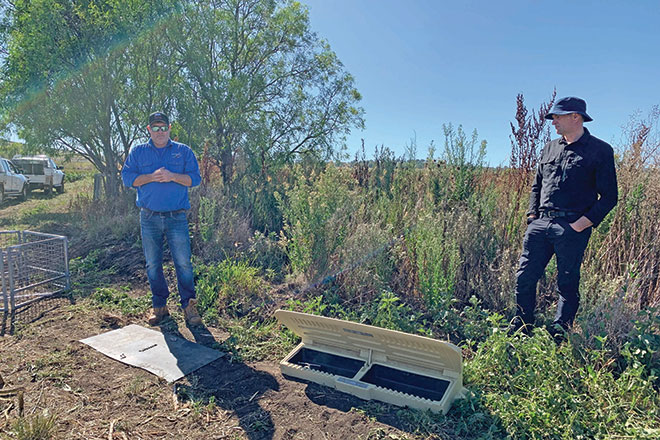ABOVE: Demonstrating baiting and trapping for effective feral pig management. Darren Marshall from SQ Landscapes in Queensland and Richard Evison from Westpork.
As many of you know, the National Feral Pig Action Plan promotes coordinated and collective efforts by land managers to suppress feral pig populations, reduce their destructive impacts and minimise biosecurity risks over the long term.
Legislation across all states and territories places responsibility on land managers to prevent the spread of feral pigs on their land.
To do this, it’s important for land managers to work together to share the load, equipment, cost, labour and time needed to effectively conduct control activities and for integrated best-practice management approaches to be used.
This means that different combinations of humane best-practice management and monitoring tools need to be strategically applied, used in the right way and at the right time to optimise outcomes from population control activities.
When selecting which management methods to use, consider the distribution and abundance of feral pigs that you think are present and the habitat, as well as the non-target species that may be in the area.
A set of videos developed by Agriculture Victoria is now available to assist land managers with vertebrate pest control, including feral pigs.
While these resources have been prepared to assist land managers to comply with Victorian legislation – including that only shelf-stable manufactured 1080 baits can be used in Victoria – the principles, tips and tricks that are presented on how to apply the different feral pig control and monitoring tools are applicable to all land managers dealing with feral pigs.
For Australian Pork Industry Quality Assurance Program certified producers who are looking to be verified against the Voluntary Enhanced Biosecurity Standards for African Swine Fever, the information contained in these resources may assist you with your feral pig surveillance program for your property.
The videos can be accessed via these links:
- Controlling feral pigs on your farm in Victoria, https://youtu.be/RkxbsXkjCwI
- Baiting feral pigs in Victoria – covers the use of 1080 shelf-stable manufactured baits and Hoggone, https://youtu.be/A1J7VYlNA8o
- Trapping feral pigs in Victoria, https://youtu.be/q8YXqk8X6Ls
- Supplementary feral pig control options in Victoria, https://youtu.be/i3gjRYnLrDA
- Monitoring pest animals in Victoria, make it part of your plan – this video also provides practical advice on monitoring of foxes and rabbits, https://youtu.be/4mse44xPnsY
For those land managers who are being impacted by feral pigs, it’s recommended that a benchmark of impacts and abundance be established on your and your neighbours’ properties.
For this, consider what is being affected, how many animals are present, where they are, what control methods would be best used to achieve your control objectives and how this could be measured – for example, area of land damage, crop and pasture damage, lambing and marking percentages and so on.
A tip – consistency in what monitoring is undertaken and how it is done is key to being able to measure changes resulting from feral pig management actions over time.
This information will then be used to measure the effectiveness of your program progressively.
Data collected can be recorded into free programs such as FeralScan – feralscan.org.au/feralpigscan – which can also then act as a data repository.
Privacy can be easily managed by forming a closed group.
With all of this, planning is essential.
While it can be viewed as being time consuming and onerous, it is very important, as the process will enable the problem to be defined, objectives to be set, provide clarity on what success looks like, what management tools will be used, who will use them, how and when, and what data will be collected.
More information on management planning can be found on the PestSmart website – pestsmart.org.au
Finally, having a resident coordinator to oversee local activities and bring neighbours together is a key feature of a successful group – this is a common factor across the National Feral Pig Action Plan’s demonstration sites.
Feel free to contact me on heather.channon@feralpigs.com.au or call 0423 056 045 to discuss your feral pig management issues or any information presented in this article.







